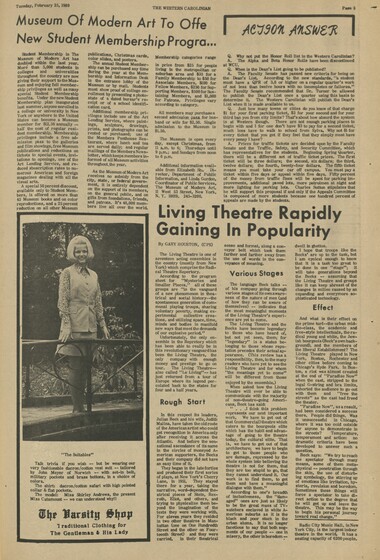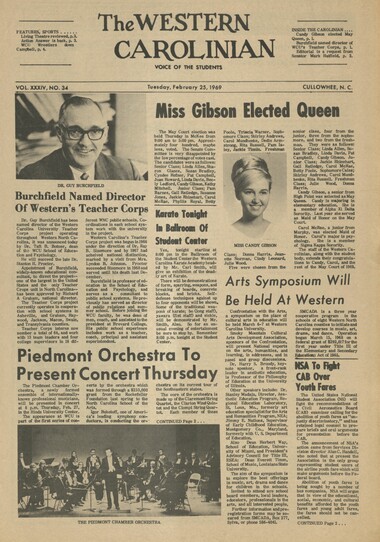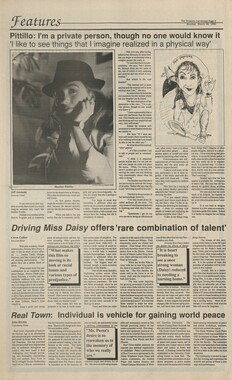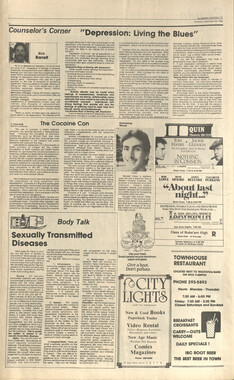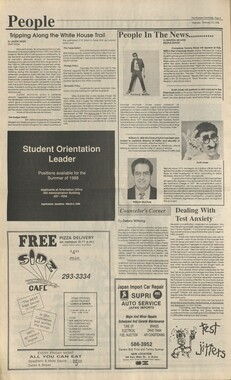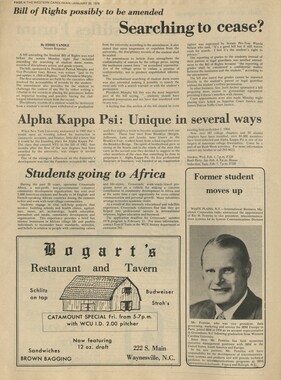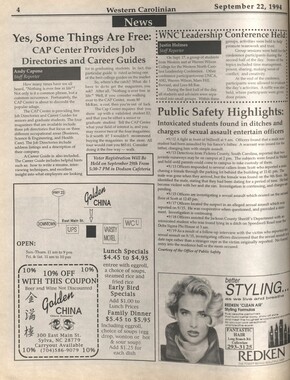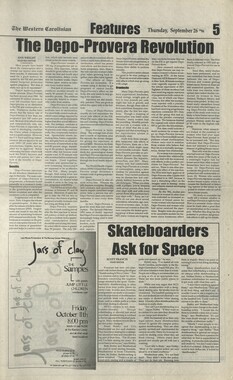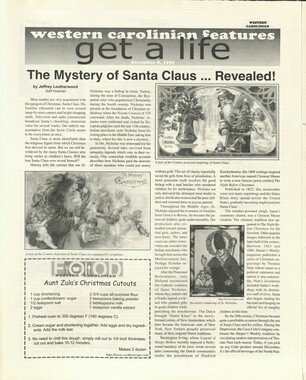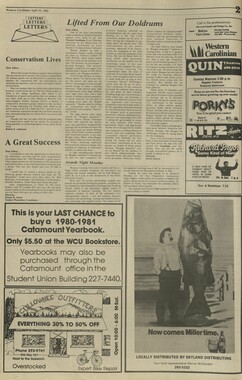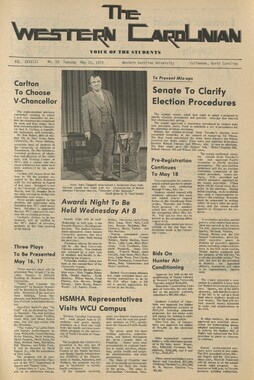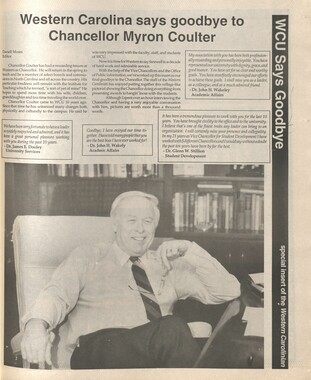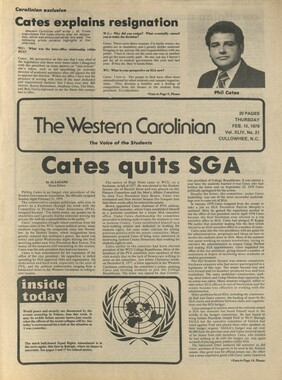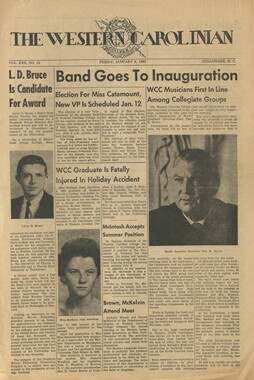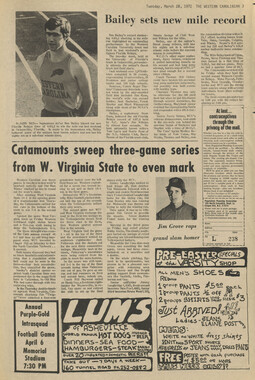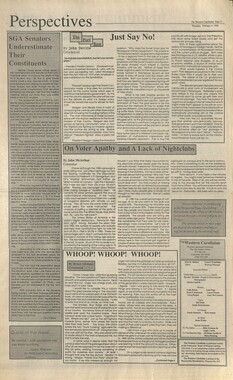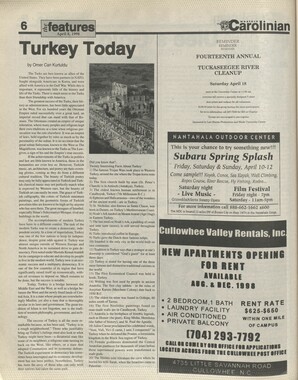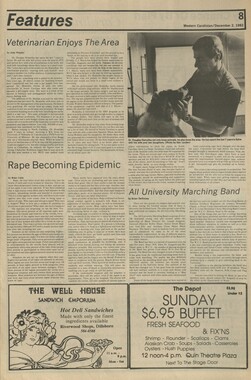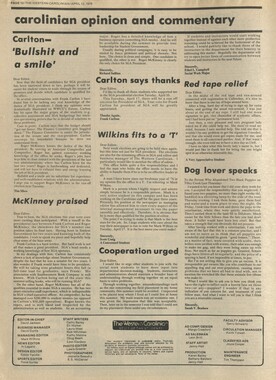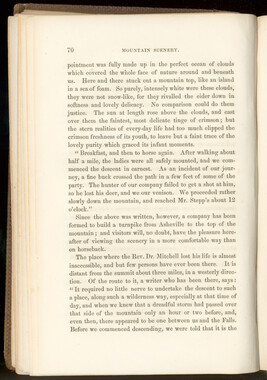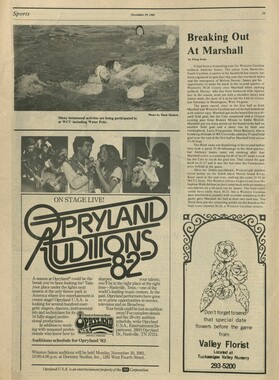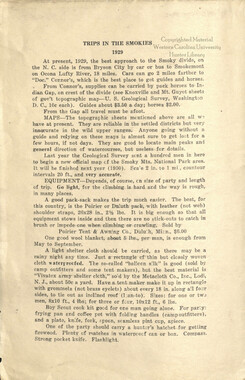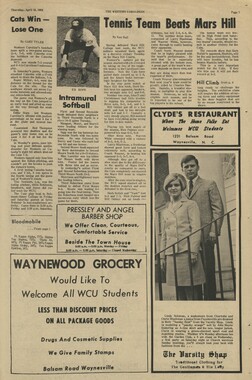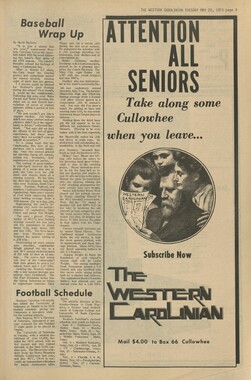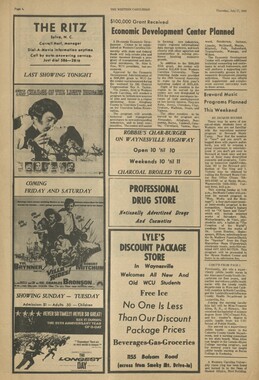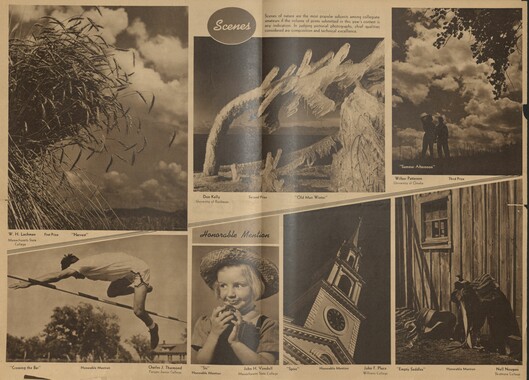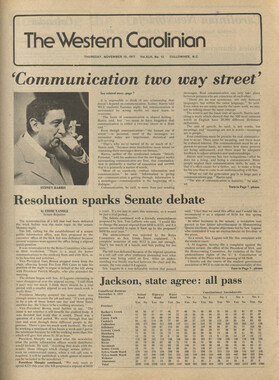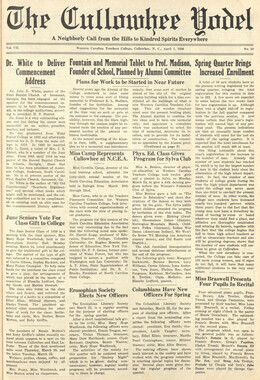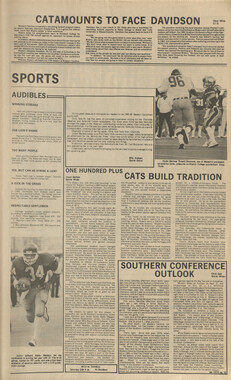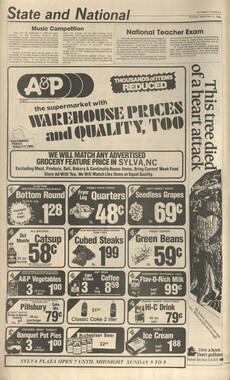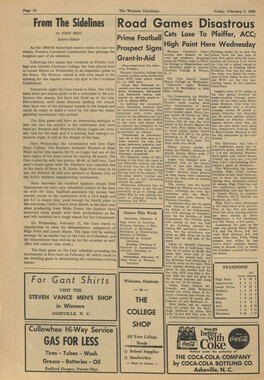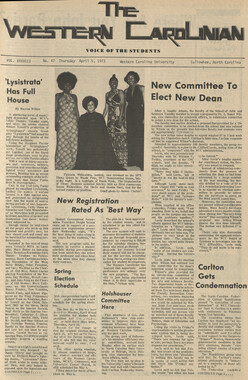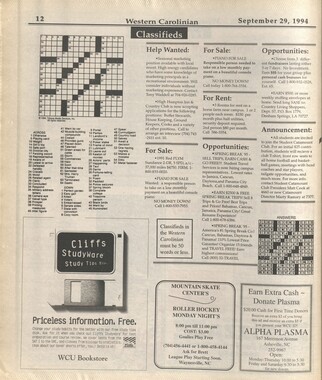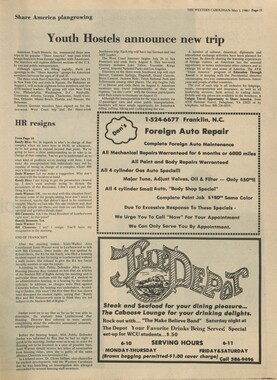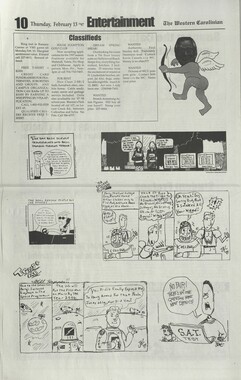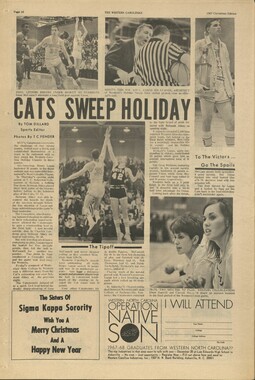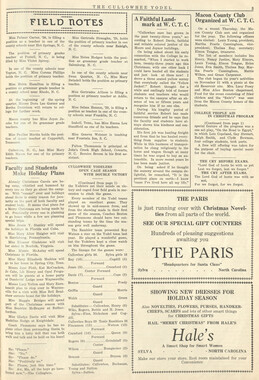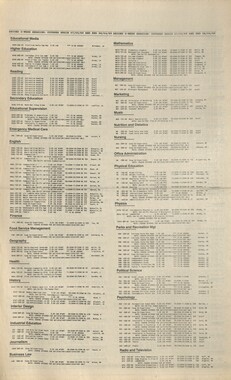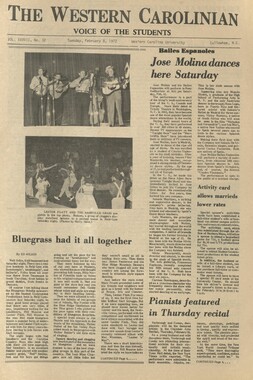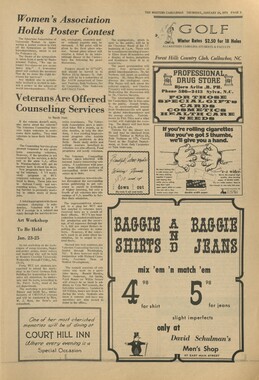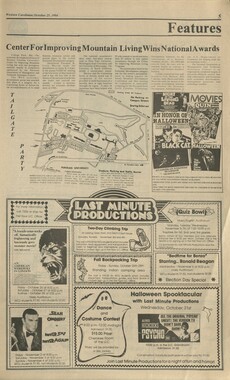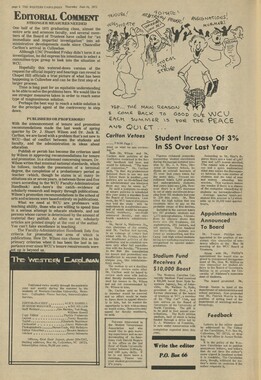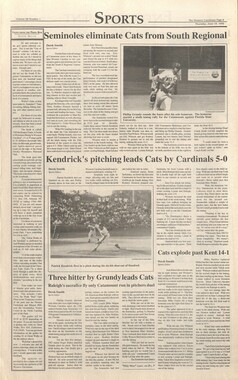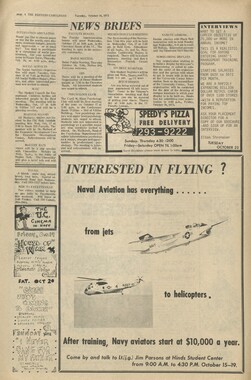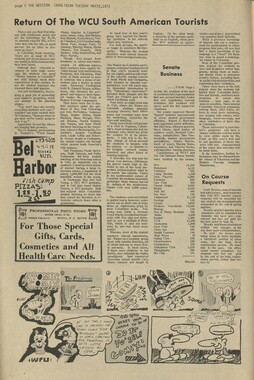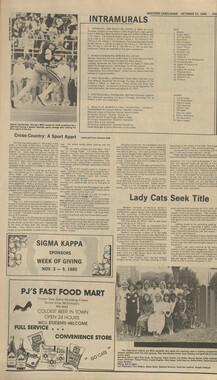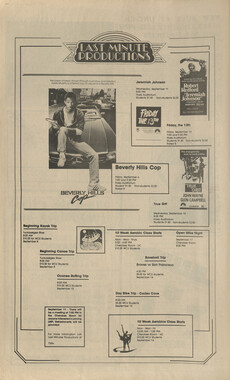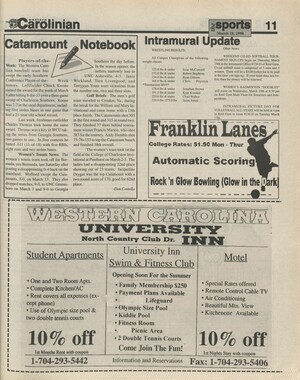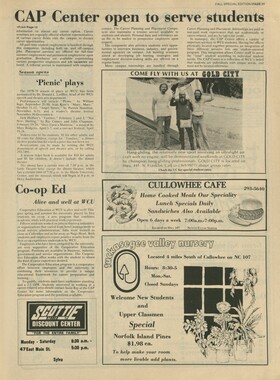Western Carolina University (20)
View all
- Canton Champion Fibre Company (2308)
- Cherokee Traditions (293)
- Civil War in Southern Appalachia (165)
- Craft Revival (1942)
- Great Smoky Mountains - A Park for America (2767)
- Highlights from Western Carolina University (430)
- Horace Kephart (941)
- Journeys Through Jackson (154)
- LGBTQIA+ Archive of Jackson County (26)
- Oral Histories of Western North Carolina (314)
- Picturing Appalachia (6772)
- Stories of Mountain Folk (413)
- Travel Western North Carolina (160)
- Western Carolina University Fine Art Museum Vitreograph Collection (129)
- Western Carolina University Herbarium (92)
- Western Carolina University: Making Memories (708)
- Western Carolina University Publications (2283)
- Western Carolina University Restricted Electronic Theses and Dissertations (146)
- Western North Carolina Regional Maps (71)
- World War II in Southern Appalachia (131)
University of North Carolina Asheville (6)
View all
- Western Carolina College (199)
- Western Carolina Teachers College (239)
- Western Carolina University (1792)
- Allanstand Cottage Industries (0)
- Appalachian National Park Association (0)
- Bennett, Kelly, 1890-1974 (0)
- Berry, Walter (0)
- Brasstown Carvers (0)
- Cain, Doreyl Ammons (0)
- Carver, George Washington, 1864?-1943 (0)
- Cathey, Joseph, 1803-1874 (0)
- Champion Fibre Company (0)
- Champion Paper and Fibre Company (0)
- Cherokee Indian Fair Association (0)
- Cherokee Language Program (0)
- Crittenden, Lorraine (0)
- Crowe, Amanda (0)
- Edmonston, Thomas Benton, 1842-1907 (0)
- Ensley, A. L. (Abraham Lincoln), 1865-1948 (0)
- Fromer, Irving Rhodes, 1913-1994 (0)
- George Butz (BFS 1907) (0)
- Goodrich, Frances Louisa (0)
- Grant, George Alexander, 1891-1964 (0)
- Heard, Marian Gladys (0)
- Kephart, Calvin, 1883-1969 (0)
- Kephart, Horace, 1862-1931 (0)
- Kephart, Laura, 1862-1954 (0)
- Laney, Gideon Thomas, 1889-1976 (0)
- Masa, George, 1881-1933 (0)
- McElhinney, William Julian, 1896-1953 (0)
- Niggli, Josephina, 1910-1983 (0)
- North Carolina Park Commission (0)
- Osborne, Kezia Stradley (0)
- Owens, Samuel Robert, 1918-1995 (0)
- Penland Weavers and Potters (0)
- Rhodes, Judy (0)
- Roberts, Vivienne (0)
- Roth, Albert, 1890-1974 (0)
- Schenck, Carl Alwin, 1868-1955 (0)
- Sherrill's Photography Studio (0)
- Smith, Edward Clark (0)
- Southern Highland Handicraft Guild (0)
- Southern Highlanders, Inc. (0)
- Stalcup, Jesse Bryson (0)
- Stearns, I. K. (0)
- Thompson, James Edward, 1880-1976 (0)
- United States. Indian Arts and Crafts Board (0)
- USFS (0)
- Vance, Zebulon Baird, 1830-1894 (0)
- Weaver, Zebulon, 1872-1948 (0)
- Western Carolina University. Mountain Heritage Center (0)
- Whitman, Walt, 1819-1892 (0)
- Wilburn, Hiram Coleman, 1880-1967 (0)
- Williams, Isadora (0)
- 1920s (57)
- 1930s (69)
- 1940s (114)
- 1950s (66)
- 1960s (314)
- 1970s (599)
- 1980s (406)
- 1990s (379)
- 2000s (195)
- 2010s (83)
- 1600s (0)
- 1700s (0)
- 1800s (0)
- 1810s (0)
- 1820s (0)
- 1830s (0)
- 1840s (0)
- 1850s (0)
- 1860s (0)
- 1870s (0)
- 1880s (0)
- 1890s (0)
- 1900s (0)
- 1910s (0)
- 2020s (0)
- Jackson County (N.C.) (2282)
- Appalachian Region, Southern (0)
- Asheville (N.C.) (0)
- Avery County (N.C.) (0)
- Blount County (Tenn.) (0)
- Buncombe County (N.C.) (0)
- Cherokee County (N.C.) (0)
- Clay County (N.C.) (0)
- Graham County (N.C.) (0)
- Great Smoky Mountains National Park (N.C. and Tenn.) (0)
- Haywood County (N.C.) (0)
- Henderson County (N.C.) (0)
- Knox County (Tenn.) (0)
- Knoxville (Tenn.) (0)
- Lake Santeetlah (N.C.) (0)
- Macon County (N.C.) (0)
- Madison County (N.C.) (0)
- McDowell County (N.C.) (0)
- Mitchell County (N.C.) (0)
- Polk County (N.C.) (0)
- Qualla Boundary (0)
- Rutherford County (N.C.) (0)
- Swain County (N.C.) (0)
- Transylvania County (N.C.) (0)
- Watauga County (N.C.) (0)
- Waynesville (N.C.) (0)
- Yancey County (N.C.) (0)
- Newsletters (510)
- Publications (documents) (1773)
- Aerial Photographs (0)
- Aerial Views (0)
- Albums (books) (0)
- Articles (0)
- Artifacts (object Genre) (0)
- Bibliographies (0)
- Biography (general Genre) (0)
- Cards (information Artifacts) (0)
- Clippings (information Artifacts) (0)
- Crafts (art Genres) (0)
- Depictions (visual Works) (0)
- Design Drawings (0)
- Drawings (visual Works) (0)
- Envelopes (0)
- Facsimiles (reproductions) (0)
- Fiction (general Genre) (0)
- Financial Records (0)
- Fliers (printed Matter) (0)
- Glass Plate Negatives (0)
- Guidebooks (0)
- Internegatives (0)
- Interviews (0)
- Land Surveys (0)
- Letters (correspondence) (0)
- Manuscripts (documents) (0)
- Maps (documents) (0)
- Memorandums (0)
- Minutes (administrative Records) (0)
- Negatives (photographs) (0)
- Newspapers (0)
- Occupation Currency (0)
- Paintings (visual Works) (0)
- Pen And Ink Drawings (0)
- Periodicals (0)
- Personal Narratives (0)
- Photographs (0)
- Plans (maps) (0)
- Poetry (0)
- Portraits (0)
- Postcards (0)
- Programs (documents) (0)
- Questionnaires (0)
- Scrapbooks (0)
- Sheet Music (0)
- Slides (photographs) (0)
- Songs (musical Compositions) (0)
- Sound Recordings (0)
- Specimens (0)
- Speeches (documents) (0)
- Text Messages (0)
- Tintypes (photographs) (0)
- Transcripts (0)
- Video Recordings (physical Artifacts) (0)
- Vitreographs (0)
- The Reporter, Western Carolina University (510)
- WCU Students Newspapers Collection (1744)
- A.L. Ensley Collection (0)
- Appalachian Industrial School Records (0)
- Appalachian National Park Association Records (0)
- Axley-Meroney Collection (0)
- Bayard Wootten Photograph Collection (0)
- Bethel Rural Community Organization Collection (0)
- Blumer Collection (0)
- C.W. Slagle Collection (0)
- Canton Area Historical Museum (0)
- Carlos C. Campbell Collection (0)
- Cataloochee History Project (0)
- Cherokee Studies Collection (0)
- Daisy Dame Photograph Album (0)
- Daniel Boone VI Collection (0)
- Doris Ulmann Photograph Collection (0)
- Elizabeth H. Lasley Collection (0)
- Elizabeth Woolworth Szold Fleharty Collection (0)
- Frank Fry Collection (0)
- George Masa Collection (0)
- Gideon Laney Collection (0)
- Hazel Scarborough Collection (0)
- Hiram C. Wilburn Papers (0)
- Historic Photographs Collection (0)
- Horace Kephart Collection (0)
- Humbard Collection (0)
- Hunter and Weaver Families Collection (0)
- I. D. Blumenthal Collection (0)
- Isadora Williams Collection (0)
- Jesse Bryson Stalcup Collection (0)
- Jim Thompson Collection (0)
- John B. Battle Collection (0)
- John C. Campbell Folk School Records (0)
- John Parris Collection (0)
- Judaculla Rock project (0)
- Kelly Bennett Collection (0)
- Love Family Papers (0)
- Major Wiley Parris Civil War Letters (0)
- Map Collection (0)
- McFee-Misemer Civil War Letters (0)
- Mountain Heritage Center Collection (0)
- Norburn - Robertson - Thomson Families Collection (0)
- Pauline Hood Collection (0)
- Pre-Guild Collection (0)
- Qualla Arts and Crafts Mutual Collection (0)
- R.A. Romanes Collection (0)
- Rosser H. Taylor Collection (0)
- Samuel Robert Owens Collection (0)
- Sara Madison Collection (0)
- Sherrill Studio Photo Collection (0)
- Smoky Mountains Hiking Club Collection (0)
- Stories of Mountain Folk - Radio Programs (0)
- Venoy and Elizabeth Reed Collection (0)
- WCU Gender and Sexuality Oral History Project (0)
- WCU Mountain Heritage Center Oral Histories (0)
- WCU Oral History Collection - Mountain People, Mountain Lives (0)
- Western North Carolina Tomorrow Black Oral History Project (0)
- William Williams Stringfield Collection (0)
- Zebulon Weaver Collection (0)
- College student newspapers and periodicals (1769)
- African Americans (0)
- Appalachian Trail (0)
- Artisans (0)
- Cherokee art (0)
- Cherokee artists -- North Carolina (0)
- Cherokee language (0)
- Cherokee pottery (0)
- Cherokee women (0)
- Church buildings (0)
- Civilian Conservation Corps (U.S.) (0)
- Dams (0)
- Dance (0)
- Education (0)
- Floods (0)
- Folk music (0)
- Forced removal, 1813-1903 (0)
- Forest conservation (0)
- Forests and forestry (0)
- Gender nonconformity (0)
- Great Smoky Mountains National Park (N.C. and Tenn.) (0)
- Hunting (0)
- Landscape photography (0)
- Logging (0)
- Maps (0)
- Mines and mineral resources (0)
- North Carolina -- Maps (0)
- Paper industry (0)
- Postcards (0)
- Pottery (0)
- Railroad trains (0)
- Rural electrification -- North Carolina, Western (0)
- School integration -- Southern States (0)
- Segregation -- North Carolina, Western (0)
- Slavery (0)
- Sports (0)
- Storytelling (0)
- Waterfalls -- Great Smoky Mountains (N.C. and Tenn.) (0)
- Weaving -- Appalachian Region, Southern (0)
- Wood-carving -- Appalachian Region, Southern (0)
- World War, 1939-1945 (0)
- Text (2283)
- MovingImage (0)
- Sound (0)
- StillImage (0)
Western Carolinian Volume 34 Number 34
Item
Item’s are ‘child’ level descriptions to ‘parent’ objects, (e.g. one page of a whole book).
-
-
Tuesday, February 25, 1969 THE WESTERN CAROLINIAN Museum Of Modern Art To Offe \ New Student Membership Progra... Aado% jfuswtT, Student Membership in The Museum of Modern Art has doubled within the last year. More' than 5,000 students in colleges and universities throughout the country are now giving their support to the Museum and enjoying full membership privileges as well as many special Student Membership benefits. Under the new Student Membership plan inaugurated last summer, anyone enrolled in a college or university in New York or anywhere in the United States can become a Museum member for $12.50 annually — half the cost of regular resident membership. Membership privileges include a free admission pass to the galleries and film showings, free Museum publications and reductions on tickets to special events, invitations to openings, use of the Art Lending Service, and reduced sbuscription rates to numerous American and foreign magazines dealing with all the visual arts. A special 50 percent discount, available only to Student Members, is offered on more than 45 Museum books and on color reproductions, and a 25 percent reduction on all other Museum publications, Christmas cards, color slides, and posters. The annual Student Membership can be purchased any time during the year at the Membership and Information Desk in the entrance lobby of the Museum or by mail. Students must show proof of college enrollment by presenting a photo- state of a dated bursar's receipt or of a school identification card. Additional membership privileges include use of the Art Lending Service, where paintings, sculpture, drawings, prints, and photographs can be rented or purchased; use of the Members Penthouse Restaurant, where lunch and tea are served daily; and regular mailings of the Members Newsletter, which keeps members informed of all Museum activities throughoutjhe year. As the Museum of Modern Art receives no subsidy from the city, state, or federal government, it is entirely dependent on the support of its members, on the general public, and on gifts from foundations, friends, and patrons. It's 40,000 members live all over the world. "The Suitables" Talk trivia if you wish -- but be wearing our very fashionable dacr on/cotton vest suit — tailored by John Meyer of Norwich — with set-in belt, military pockets and brass buttons, in a choice of colors. The shirt: dacron/cotton safari with high pointed collar & flat pockets. The model: Miss Shirley Andrews, the present Miss Catamount ~ we can understand why!I ®hr BarBtiu. #hop 1 radittonal Clothing for The Gentleman fr His Lady Membership categories range in price from $25 for people living in the metropolitan or suburban area and $35 for a Family Membership to $50 for Associate Members, $100 for Fellow Members, $250 for Supporting Members, $500 for Sustaining Members, and $1,000 for Patrons. Privileges vary according to category. All members may purchase a second admission pass, for husband or wife for $2.50. Single admission to the Museum is $1.50. The Museum is open every day, except Christmas, from 11 a.m. to 6; Thursdays until 9 p.m.; and Sundays from noon to 6 p.m. Additional information available from Elizabeth Sh_ Director, Department of Public Information, and Linda Gordon, Coordinator of Public Services, The Museum of Modern Art, U West 53 Street, New York, N. Y, 10019. 245-3200. Q. Why not put the Honor Roll list in the Western Carolinian? A. The Alpha and Beta Honor Rolls have been discontinued at WCU. 0. When Is the Dean's List going to be published? A. The Faculty Senate has passed new criteria for being on the Dean's List. According to the new standards, "a student must have a QPR of 3.0 or higher on a regular quarter's work of not less than twelve hours with no Incompletes or failures." The Faculty Senate recommended that Dr. Turner be allowed to publish the Dean's List once a quarter using this basis to determine It The Western Carolinian will publish the Dean's List when it is made available to us. Q. Just how many towns or cities do you know of that charge $1 for your first parking ticket, $3 for your second and for your third ban you from city limits? That's about how absurd the system is at Western though. There are not enough parking places to begin with and I for one don't have $3 to pay for a second ticket, much less have to walk to school from Sylva. Why not $1 for every ticket that you get if they feel that they simply must have every penny I have? A. Prices for traffic tickets are decided upon by the Faculty Senate and the Traffic, Safety, and Security Committee, which has representatives for the students. Beginning Spring Quarter, there will be a different set of traffic ticket prices. The first ticket will be three dollars; the second, six dollars; the third, twelve dollars; the fourth, twenty-four dollars. The fifth ticket means you must take your car off campus. You must pay a ticket within five days or appeal within five days. Fifty percent of the money from traffic fines will be spent for parking improvements, additional paved lots, more patrolmen at night and more lighting for parking lots. Charles Sutton stipulates that he will support this proposal if and only If the Appeals Committee Is composed of more students because one hundred percent of appeals are made by the students. Living Theatre Rapidly Gaining In Popularity By GARY HOUSTON, (CPS) The Living Theatre is one of seventeen acting ensembles in the country (mostly from New York) which comprise the Radical Theatre Repertory. According to the program sheet for "Mysteries and Smaller Pieces," all of these groups are "in the vanguard of a new phenomenon in theatrical and social history—the spontaneous generation of communal playing troups, sharing voluntary poverty, making experimental collective creations, and utilizing space, time, minds and bodies in manifold new ways that meet the demands of our explosive period." Unfortunately, the only ensemble in the Repretory which has been able to really be in this revolutionary vanguard has been the Living Theatre, the only company with enough money and prestige to go on tour. The Living Theatre— also called "Le Living"— has just returned from a tour of Europe where its legend percolated back to the states for four and a half years. Rough Start In this respect its leaders, Julian Beck and his wife, Judith Malina, have taken the old route of the American artist who could get recognition in America only after receiving it across the Atlantic. And before the sensational ascendance of its name in the circles of moneyed A- merican supporters, the Becks and their company did not have an easy time of It They began in the late forties and produced their first series of plays, at New York's Cherry Lane, in 195L They stayed there for a year, taking the narrative, word-dependent theatrical pieces of Stein, Rex- roth, Eliot, and others, and trying to physicallze them beyond the Imagination of the texts they were working with. For eleven years they resided in two other theatres in Manhattan (one on One Hundredth Street and the other on Fourteenth Street) and they were carried, in their theatrical sense and format, along a conveyor belt which took them farther and farther away from the use of words in the conveyance of meaning. Various Stages The language Beck talks — of his company going through various stages of its own awareness of the nature of men (and of how they can be aware of themselves) ~ indicates that the most meaningful moments of the Living Theatre's experience are yet to come. The Living Theatre and the Becks have become legendary to those who have heard of, but not yet seen, them; for "legendary" is a status belonging to those whose reputation precedes their actual appearance. (This review has a responsibility, then, to the many readers who have yet to seethe Living Theatre and for whom "the meanings yet to come" will be different from those enjoyed by the ensemble.) When asked how the Living Theatre will ever be able to communicate with the majority of non-theatre-going Americans, Beck has said: " . . .1 think this problem represents our next important work. We have to get out of that (commercial) theatre which caters to the bourgeois elite which has the habit and advantage of going to the theatre today, the cultural elite. That is, we have to get out of that architecture; we have to begin to get to those people who are damage, repressed by the whole system into believing the theatre is not for them, that they are too stupid to go, that they cannot understand it Our work is to find them, to get them and have a meaningful dialogue with them." According to one's breadth of inclusiveness, the "damaged" ones are just as likely to be the great mass of TV- watchers enclaved in white A- merican suburbs as it is the black and poor stuck in the urban slums. It is no longer facetious to say that both segments of our people — one in misery, the other in boredom — dwell in ghettos. I hope that troops like the Becks' are up to the task, but I am cynical enough to know that it is a task too great to be done In one "stage"; It will take generations beyond the Becks — assuming that the Living Theatre and groups like it can keep abreast of the changes in milieu caused by an expanding and everymore sophisticated technology. Effect And what is their effect on the prime turf—the urban middle-class, the academic and free-style intellectuals, the radical young and white, the Jewish bourgeois (Beck's own background), and the members of the liberal Establishment? The Living Theatre played In New York, Boston, Rochester and other cities before coming to Chicago's Hyde Park. In Boston, a riot was almost created at the end of "Paradise Now" when the cast, stripped to the legal G-string and bra limits, exhorted the audience to go out with them and "free the streets" as the cast had freed the theater. "Paradise Now", as a result, had been considered a success there. People did things. Was it unsuccessful in Chicago, where it was too cold outside for anyone to demonstrate in the streets? Temperature, temperament and action: no dramatic criteria have been developed to answer such a question. Beck says: "We try to reach the spectator through many means, some of them metaphysical — penetration through the skin, the use of disturbing symbology, the stirring up of emotions like irritation, hysteria, revulsion and boredom. Sometimes these things will force a spectator to take direct action to the degree that he will get up and leave the theatre. This may be the way to begin his personal journey toward real change." Radio City Music Hall, in New York City, is the largest indoor theatre in the world. It has a seating capacity of 6200 people.
Object
Object’s are ‘parent’ level descriptions to ‘children’ items, (e.g. a book with pages).
-
The Western Carolinian is Western Carolina University’s student-run newspaper. The paper was published as the Cullowhee Yodel from 1924 to 1931 before changing its name to The Western Carolinian in 1933.
-
